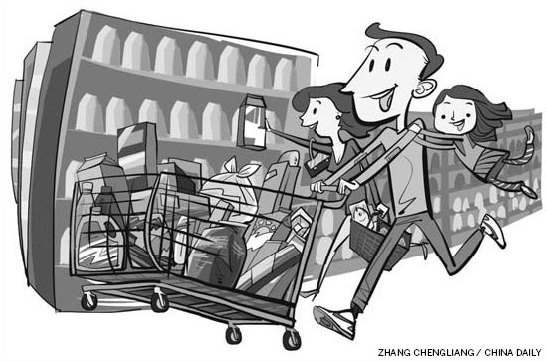


Retail | Koh Yew Hong
China's retail industry increasingly resembles an army of mice running on wheels. More and more money is being invested, but at the end of the day, companies find themselves running neck and neck with the rest of the competition, with nothing much to show for all the effort.
The 2012 financial results of listed retailers all paint the same picture. Profits are slowly but surely being eroded, and operating margins are increasingly being squeezed in the face of rising costs and intensifying competition.
It seems that the mighty consumption engine of the Chinese middle class is starting to show signs of wear and tear as consumers wise up to simplistic marketing tactics and make smarter buying decisions.
Fighting the price war is a zero-sum game that in the long term destroys an industry's profitability. Many companies now realize that the sustainable way of competing while increasing the industry pie is to make innovation a strategic focus and to continually create the first-mover advantage. They need to become "fast" companies to survive in the modern retail industry.
What makes a fast company? It must have the right products, develop customer-led insight, cultivate fast innovation and set up an enabling partner network.
For instance, fast-fashion leader Zara is finely tuned to customer desires. The company's central teams from different divisions maintain close relations with stores. Every day, managers not only send obligatory sales reports, they also detail what hasn't sold and why.
If a customer eschews a given product, in-store representatives ask, "What's the problem? Are the stripes too wide?" If they are, Zara narrows them. Autumnal colors are all the rage? Zara changes its color palette. Few other retailers have created the loop Zara maintains between on-the-floor feedback to design and manufacturing.
Beauty and healthcare chain Watsons has also developed its customer insight to a high degree. Its market research into buying patterns found that female working professionals aged 18 to 35 like to splurge on themselves for their birthdays. In response, Watsons introduced the "birthday month special", where Watsons card members are given double their reward points for every purchase during their birthday month.
Watsons also found that women were using normal plasters as makeshift protection from painful abrasions caused by wearing heels. Identifying this as an opportunity to meet a customer need, Watsons introduced a purpose-made protective plaster for women who wear heels.
Being able to correctly and regularly identify what customers want creates a competitive advantage, and having in place the proper systems to gather this market information is critical for retail success.
Product lifecycles have become increasingly compressed and the risk of product obsolescence has become a huge challenge for many retail companies. Being able to innovate continuously is proving invaluable in today's fast-paced market.
China's largest leather footwear manufacturer, Aokang Group, has its own innovation assembly line that emphasizes the speed to market of all new products - 24 hours for conceptualization, three hours for production, 24 hours for distribution - and then the product is taken off the shelves in just 30 days. This speed has shaken up the retail scene for leather goods and increased the market for leather footwear.
The hard truth is that there exists a time premium for retail goods. The first to the game gets the lion's share of profit while the stragglers will always be left picking up the scraps.
When it comes to the speed of product release, perhaps retailers can learn a thing or two from the software industry about iterative product development, where the product is put into the market first and then incrementally revised or upgraded after the retailer has gathered user feedback.
This strategy avoids the trap of overly long gestation periods in product design and working only on improvements that they already know customers will value.
The development of new products often requires drawing on the network of business partners to achieve first-to-market advantage. US retailer Target joined forces with Italian fashion house Missoni to create a product launch so powerful that the company's online website crashed because of demand overload. Shelves were empty in some stores in minutes. The practice began in the fast fashion field with stores like H&M and Debenhams. With the success of Target/Missoni, the strategy shows no sign of slowing.
Winning in retail requires not only being right - it requires being right now. Creating differentiated, high-demand products will not add to profit margins if they are introduced a season too late. Getting the right products to market quickly requires strong capabilities in three key areas: repeatable platforms, integrated planning and agile multichannel supply chains.
Repeatable platforms: Many companies now realize that innovation needs to be structured and organized in a way that allows them to build innovations off past successes, rather than starting from scratch each time.
Executing a product launch is an exercise in precise project management, where the overall strategy and the sales, marketing and inventory management plan, all come together to deliver the product to market with the greatest impact.
Customers are demanding more and more from their retail experience but many companies are still stuck in the old ways. Looking at the brutal pace of change and competition in today's market, retailers that fail to evolve their culture and practices into those of a fast company may suffer fatal consequences sooner rather than later.
The author is managing director of retail lead for Accenture in China. The views do not necessarily reflect those of China Daily.
 Models at Ford pavilion at Chengdu Motor Show
Models at Ford pavilion at Chengdu Motor Show
 Brilliant future expected for Chinese cinema: interview
Brilliant future expected for Chinese cinema: interview
 Chang'an launches Eado XT at Chengdu Motor Show
Chang'an launches Eado XT at Chengdu Motor Show
 Hainan Airlines makes maiden flight to Chicago
Hainan Airlines makes maiden flight to Chicago
 Highlights of 2013 Chengdu Motor Show
Highlights of 2013 Chengdu Motor Show
 New Mercedes E-Class China debut at Chengdu Motor Show
New Mercedes E-Class China debut at Chengdu Motor Show
 'Jurassic Park 3D' remains atop Chinese box office
'Jurassic Park 3D' remains atop Chinese box office
 Beauty reveals secrets of fashion consultant
Beauty reveals secrets of fashion consultant